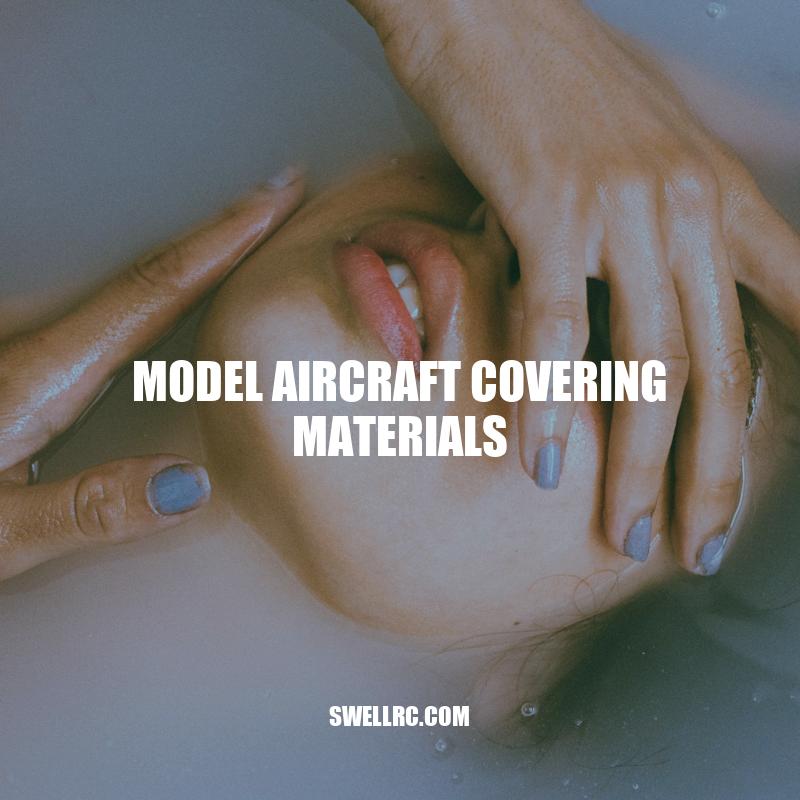Model Aircraft Covering Materials: A Comprehensive Guide
Model aircraft covering materials play a crucial role in the world of model aircraft enthusiasts. These materials are responsible for preserving the plane’s structure, keeping it lightweight, and aiding in its aerodynamics. Covering materials are typically made from plastic film, polyester fabrics, or shrink-wrap materials, and each has their pros and cons. The type of material used can have an impact on the plane’s overall performance, including its speed, stability, and durability. Therefore, it’s essential to choose the right covering material for your aircraft. Making an informed choice can mean the difference between a successful flight or a disastrous outcome. In this article, we will dive deeper into the world of model aircraft covering materials and discuss the different types available, their uses and advantages, and how to choose the right one for your model aircraft.
Types of Model Aircraft Covering Materials
There are different types of model aircraft covering materials available with their pros and cons. Here are some of the most commonly used materials:
- Plastic Film: This is the most popular type of covering material. It is lightweight and easy to apply. Plastic film is usually heat-shrunk to the model’s surface, providing a tight and wrinkle-free finish. However, it’s more prone to punctures and tears compared to other materials.
- Polyester Fabrics: This type of covering material is durable and tear-resistant. It’s a good option for models expected to endure high stress, such as aerobatic planes. However, it tends to be heavier compared to plastic film, adding more weight to the aircraft, decreasing its performance.
- Shrink-wrap Materials: Shrink-wrap covering materials are similar to plastic films, but they are thicker and more durable. These materials are generally used for larger-scale models due to their strength. However, applying it to models requires a specific skill set and tools.
Other types of covering materials include fabrics like silk, paper, and fiberglass. However, these are less common in the model aircraft hobby, so we will focus on the three most widely used types. The choice of the material is crucial in achieving the desired finish and performance for a particular model aircraft. Nonetheless, it is essential to experiment with different materials to find which works best for different weights and complexities. If you are not sure where to purchase covering materials, websites such as Balsa USA and HobbyKing offer a wide range of options to choose from.
What are the pros and cons of using plastic film as a model aircraft covering material?
Plastic film is a popular choice for model aircraft covering materials, but it comes with its own set of advantages and disadvantages.
Firstly, one of the biggest advantages of plastic film is that it is lightweight. This makes it ideal for use in model aircraft, as it won’t add unnecessary weight that could impair the aircraft’s performance. Additionally, plastic film can be stretched tight over irregular shapes, making it easier to cover complicated parts of the aircraft.
Another advantage of plastic film is that it is inexpensive and widely available. This makes it a convenient option for model builders who are on a budget or who need to quickly replace damaged covering material.
However, there are also downsides to using plastic film as a covering material. For one, it can be more difficult to apply than other types of covering materials, like fabric or paper. Plastic film requires careful cutting and wrapping to ensure a tight, even fit, which can take time and patience.
Furthermore, plastic film is not as durable as other covering materials and can be prone to cracking or tearing. This means it may need to be replaced more frequently, which can be costly in the long run.
In summary, the lightweight and affordable nature of plastic film makes it a popular choice for model aircraft covering material. However, its tendency to crack and tear, coupled with the difficulty of application, mean that it may not be the best option for all model builders.
Importance of Choosing the Right Model Aircraft Covering Material
Choosing the right covering material for a model aircraft is crucial in achieving the desired performance and aesthetics. Some of the factors to consider include weight, durability, and heat resistance. Here are some additional factors and examples of models for which certain materials are well suited:
- High-Speed Planes: Plastic film covering materials are the lightest and, therefore, the best option for high-speed planes. They offer less wind resistance as compared to others and can withstand high G forces.
- Glider Planes: Polyester fabrics covering materials are more durable, and they can handle the stress of long flights.
- Scale Models: Shrink-wrap materials are thicker and more durable, making them perfect for larger models with more complex structures.
Some additional factors to consider are the model’s temperature requirements, the type of paints used, and the expertise and tools available to the builder. It’s important to note that while the choice of covering material affects the model’s weight and flying performance, other factors such as wing-loading, center of gravity, and airflow are also important to consider.
If you’re unsure about which covering material will work best for your specific model-building project, various online forums, such as RCGroups, provide insights from experienced model builders. There are also online tools, such as Wing Area Calculator, that can help determine the appropriate weight of the covering material for a specific model.
In conclusion, choosing the right covering material for a model aircraft helps ensure its success during flight. Knowing which materials work best for different types of aircraft ensures builders can maximize the performance of their models.
‘What are some factors to consider when choosing a covering material for a model aircraft’?
When it comes to model aircraft, choosing the right covering material is crucial for achieving optimal performance and a great look. Here are some factors to consider when choosing a covering material for your next project:
1. Weight: One of the most important factors to consider is weight. The lighter the covering material, the better your model aircraft will perform.
2. Durability: Model aircraft encounter a lot of wear and tear during flights, so it’s important to choose a covering material that can withstand the rigors of the hobby. You’ll want to make sure that the material you select has a good reputation for withstanding the effects of sunlight, heat, moisture, and wind.
3. Tautness: A taut covering material will help to create a smooth, streamlined surface on your model aircraft. This, in turn, will make it easier to fly, and will also increase your chances of success during competitions.
4. Aesthetic appeal: Finally, you’ll want to choose a covering material that looks great when applied to your aircraft. There are many options available on the market, from bright and bold colors to subtle and classic designs. Whatever your personal style, there’s sure to be a covering material that suits your needs.
By taking into account these four key factors, you can choose a covering material that will optimize the performance of your model aircraft while also allowing you to express your individual style.
Model aircraft covering materials can be applied effectively to the aircraft’s surface by following proper techniques and guidelines. The process starts with adequate cleaning and preparing the surface before applying the covering material. Sanding the surface with smooth-grit sandpaper is recommended for some models.
The covering material is then cut to size and applied one section at a time to the surface. Using a heat gun or iron, the material should be smoothed out to ensure a proper fit. Position the material and trim it, leaving a small overlap to the adjoining section.
Different brands of covering materials require different tools and techniques to be applied. Therefore, it is important to research the specific material and its application guidelines before starting the project. Brands like Oracover (Ultracote), Oratex, Coverite, and Solarfilm are popular choices for model aircraft covering materials and have their own guidelines.
Finishing the surface can be accomplished by adding decals or paint, depending on the model and personal preference. To ensure a smooth and wrinkle-free application, a covering iron or heat gun can be used during the process. Self-adhesive covering materials can significantly reduce application time.
There are multiple resources available online to provide guidance and tutorials for applying model aircraft covering materials. YouTube channels offer tutorials with step-by-step guidance for applying covering materials to model aircraft. Additionally, Oracover, Oratex, Coverite, and Solarfilm all have manuals and forums available on their websites for guidance.
In conclusion, applying covering materials to a model aircraft’s surface requires proper preparation, tools, and guidance. Researching the specific material and its application guidelines is crucial in successfully applying the covering. Ample guidance is available online, and using a covering iron or heat gun can significantly improve the application process’s outcome.
‘What tools are recommended for applying model aircraft covering materials’?
When it comes to applying model aircraft covering materials, having the right tools is key to achieving a smooth and professional finish. Here are some of the recommended tools for this task:
1. Heat Gun: A heat gun is an essential tool that will help you apply heat to the covering material, making it easier to stretch and adhere to the surface of your model aircraft. It also helps to create a seamless finish by shrinking the covering once it has been applied.
2. Iron: An iron can also be used to apply heat to the covering material, but it must be set at a very low temperature. This is because high temperatures can damage or melt the material.
3. Covering Iron: A covering iron is a specialized iron designed specifically for covering materials. It has a temperature regulator that can be set to the precise temperature needed for the type of covering material you are using.
4. Trimming Tool: A trimming tool is used to cut excess covering from your model aircraft once it has been applied. This tool ensures a neat and tidy finish.
5. Scissors: You will need a pair of sharp scissors to cut the covering material to the correct size and shape before applying it to your model aircraft.
6. Sandpaper: Sandpaper is used to smooth the surface of your model aircraft before applying the covering material. It also helps the covering to stick better.
By having these tools at your disposal, you can ensure that the application of your model aircraft covering materials is a success and that your finished product looks professional and polished.
Where to Purchase Model Aircraft Covering Materials
Model aircraft covering materials can be purchased from a variety of sources, including online stores and physical hobby shops. Here are some options for purchasing covering materials for model aircraft:
- Online Stores: Several online retailers specialize in covering materials and offer a vast selection of brands, materials, and colors. These stores offer the convenience of online shopping from home and have a significant range of products available at competitive prices. Examples include:
- HobbyKing
- Horizon Hobby
- Great Planes
- Physical Hobby Shops: Many hobby shops stock covering materials, and they offer the benefit of being able to touch and feel the materials before buying. Additionally, hobby shops provide the opportunity to get expert advice and recommendations from other hobbyists and staff. Some popular hobby shops that sell model aircraft covering materials are:
- Hobby Lobby
- Michaels
- Jo-Ann Fabric and Craft Stores
Another option is to purchase covering materials directly from the manufacturer’s website. Some popular brands such as Oracover and Coverite have their online stores, which offer exclusive deals and discounts on their products.
Before purchasing, other factors to consider are shipping time and cost, the availability of specific materials and colors, and the price point.
For items that might be challenging to find, eBay and Amazon offer an extensive selection of products. It’s important, however, to be cautious when purchasing from third-party sellers and verify the quality of the product before purchasing.
In conclusion, finding the right supplier for model aircraft covering materials depends on personal preference, such as shipping time/availability of specific brands, and price point, and is best determined by comparing options from various sources.
‘What are some popular online retailers for model aircraft covering materials’?
There are several online retailers that offer a wide variety of model aircraft covering materials. For those looking for a reliable option, Aircraft Spruce is a popular choice. They offer an extensive selection of covering materials, including popular brands such as Ultracote and Solartex. Another popular choice is Hobby King, known for their affordable prices and extensive selection of hobby supplies. Other popular online retailers for model aircraft covering materials include Sig Manufacturing, Fibreglass Specialties, and Balsa USA. It’s important to do your research and compare prices before making a purchase to ensure you are getting the best value for your money. With these options readily available, finding the materials you need to complete your model aircraft project has never been easier.
Conclusion
In conclusion, selecting the appropriate covering material is crucial in building a successful model aircraft. While there are several options available, it’s essential to consider factors such as weight, durability, cost, and performance. Polyester fabrics and plastic film are popular choices for covering materials, but shrink-wrap materials have gained significant popularity in recent years.
Installing and applying model aircraft covering materials require patience, a steady hand, and practice. To avoid errors, hobbyists should prepare the model aircraft and consult with other experienced hobbyists or refer to helpful online tutorials. Hobbyists can purchase model aircraft covering materials from various sources such as online stores, physical hobby shops, or the manufacturer’s online store. Shipping time, cost, availability, and quality are all essential factors to consider.
In conclusion, building, and flying model aircraft is a brilliant hobby that requires dedication and attention to detail. Model aircraft covering materials are just one aspect of the assembly process, but it ultimately determines the appearance and performance of the final product. Enthusiasts can experiment with different materials and techniques to find the perfect covering material that best suits their individual goals and ultimately lead to hours of enjoyable flying of their model aircrafts.



